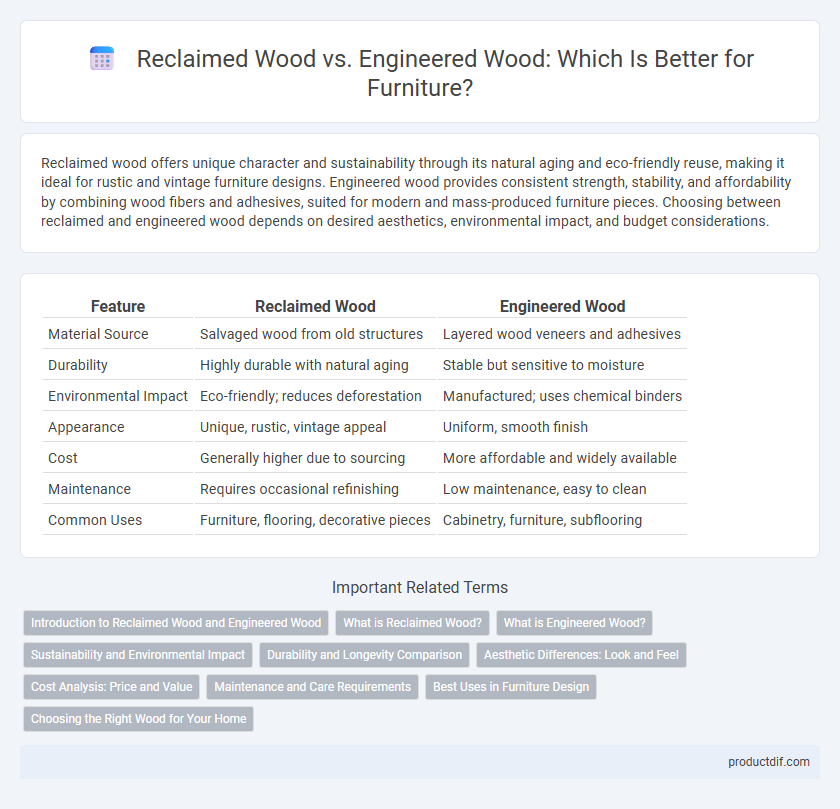Reclaimed wood offers unique character and sustainability through its natural aging and eco-friendly reuse, making it ideal for rustic and vintage furniture designs. Engineered wood provides consistent strength, stability, and affordability by combining wood fibers and adhesives, suited for modern and mass-produced furniture pieces. Choosing between reclaimed and engineered wood depends on desired aesthetics, environmental impact, and budget considerations.
Table of Comparison
| Feature | Reclaimed Wood | Engineered Wood |
|---|---|---|
| Material Source | Salvaged wood from old structures | Layered wood veneers and adhesives |
| Durability | Highly durable with natural aging | Stable but sensitive to moisture |
| Environmental Impact | Eco-friendly; reduces deforestation | Manufactured; uses chemical binders |
| Appearance | Unique, rustic, vintage appeal | Uniform, smooth finish |
| Cost | Generally higher due to sourcing | More affordable and widely available |
| Maintenance | Requires occasional refinishing | Low maintenance, easy to clean |
| Common Uses | Furniture, flooring, decorative pieces | Cabinetry, furniture, subflooring |
Introduction to Reclaimed Wood and Engineered Wood
Reclaimed wood is salvaged from old buildings, barns, or furniture, offering unique textures and eco-friendly benefits by reducing deforestation. Engineered wood, manufactured by bonding wood fibers or veneers with adhesives, provides enhanced stability and uniformity, making it ideal for modern furniture design. Both materials contribute to sustainable furniture production but differ in origin, appearance, and durability.
What is Reclaimed Wood?
Reclaimed wood is timber salvaged from old buildings, barns, or furniture, valued for its unique grain patterns, durability, and environmental benefits. This wood often carries a rich history and character, making it a popular choice for sustainable and rustic furniture designs. Its natural aging process enhances strength and reduces the need for chemical treatments compared to engineered wood products.
What is Engineered Wood?
Engineered wood is a composite material made from layers of wood veneers or fibers bonded together with adhesives, designed to provide enhanced stability and resistance to warping compared to solid wood. Common types include plywood, MDF (medium-density fiberboard), and particleboard, each offering varying degrees of strength and cost-effectiveness. Its construction allows for efficient use of raw materials and consistent performance in furniture manufacturing.
Sustainability and Environmental Impact
Reclaimed wood offers superior sustainability by repurposing old materials, reducing the demand for virgin timber and minimizing deforestation. Engineered wood, made from wood fibers and adhesives, maximizes resource efficiency and reduces waste but may involve synthetic chemicals that impact indoor air quality. Both options contribute to environmentally conscious furniture choices, with reclaimed wood generally having a lower carbon footprint due to its reuse of existing materials.
Durability and Longevity Comparison
Reclaimed wood offers superior durability due to its dense, aged fibers and natural resistance to wear, making it ideal for furniture that withstands heavy use over time. Engineered wood, while less prone to warping and swelling thanks to its manufactured layers, generally has a shorter lifespan and may deteriorate faster under moisture exposure. Choosing reclaimed wood ensures longevity and a robust structure, whereas engineered wood suits budget-friendly options with moderate durability expectations.
Aesthetic Differences: Look and Feel
Reclaimed wood features natural imperfections, weathered textures, and unique grain patterns that create a rustic, authentic aesthetic ideal for vintage and farmhouse styles. Engineered wood offers a more uniform appearance with smooth surfaces and consistent color, suited for modern and contemporary furniture designs. The tactile feel of reclaimed wood is often rougher and more textured, while engineered wood feels smoother and more polished.
Cost Analysis: Price and Value
Reclaimed wood typically has a higher upfront cost due to its harvesting, processing, and unique character, often priced between $10 to $25 per square foot, but offers exceptional durability and environmental value. Engineered wood, ranging from $4 to $12 per square foot, provides a cost-effective alternative with consistent quality and easier installation, yet may lack the long-term appeal and strength of reclaimed wood. Evaluating price versus value, reclaimed wood often delivers greater investment potential and aesthetic uniqueness, while engineered wood suits budget-conscious projects prioritizing uniformity and efficiency.
Maintenance and Care Requirements
Reclaimed wood requires regular cleaning with mild soap and water to preserve its natural patina and prevent damage from moisture or pests, often needing periodic sealing or oiling to maintain durability. Engineered wood features a protective top layer that simplifies maintenance by resisting scratches and stains, requiring only routine dusting and occasional damp cloth wiping without the need for special treatments. Both materials benefit from controlled indoor humidity to minimize warping and extend their lifespan.
Best Uses in Furniture Design
Reclaimed wood excels in rustic and eco-friendly furniture designs, offering unique character and durability for tables, chairs, and bed frames. Engineered wood, including plywood and MDF, provides consistent strength and smooth finishes ideal for modern cabinetry, shelves, and flat-pack furniture. Selecting between reclaimed and engineered wood depends on the desired aesthetic, structural needs, and sustainability priorities in furniture design.
Choosing the Right Wood for Your Home
Reclaimed wood offers unique character and environmental benefits, making it ideal for eco-conscious homeowners seeking durable, naturally aged materials that add warmth and authenticity to furniture. Engineered wood provides stability, uniformity, and resistance to warping, making it a practical choice for modern designs and budget-friendly projects requiring consistent quality. Selecting the right wood depends on balancing sustainability, aesthetic preference, durability requirements, and maintenance considerations for your home's specific needs.
Reclaimed Wood vs Engineered Wood Infographic

 productdif.com
productdif.com